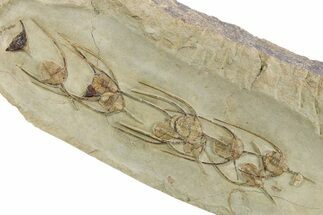This Specimen has been sold.
Line of Five Trilobites (Lonchodomas) Trilobites - Morocco
This is a really cool fossil. It is a line of five Lonchodomas trilobites nose to tail that are believed to be caught during a migration. A paper was published last year, describing similar fossils from this same locality.
480-million-year-old trilobite ‘traffic jams’ may reveal ancient migratory behavior
The largest trilobite is 2.6" long with the entire piece measuring 7.4 x 4.2"
480-million-year-old trilobite ‘traffic jams’ may reveal ancient migratory behavior
The largest trilobite is 2.6" long with the entire piece measuring 7.4 x 4.2"
About Trilobites
Trilobites are an extinct class of marine arthropods that thrived for nearly 270 million years, from the early Cambrian to the end of the Permian period (around 521 to 252 million years ago). They are one of the most successful and diverse groups in the history of life, with over 25,000 described species spanning a wide range of sizes, shapes, and ecological niches. Known for their distinctive, segmented exoskeletons, trilobites provide invaluable insights into the evolutionary history of arthropods and the dynamics of ancient marine ecosystems.
Trilobites are an extinct class of marine arthropods that thrived for nearly 270 million years, from the early Cambrian to the end of the Permian period (around 521 to 252 million years ago). They are one of the most successful and diverse groups in the history of life, with over 25,000 described species spanning a wide range of sizes, shapes, and ecological niches. Known for their distinctive, segmented exoskeletons, trilobites provide invaluable insights into the evolutionary history of arthropods and the dynamics of ancient marine ecosystems.
SPECIES
Lonchodomas (Ampyx) sp.
AGE
LOCATION
Ouled Slimane, Zagora area, Morocco
SIZE
2.6" longest trilobite, 7.4 x 4.2" rock
CATEGORY
SUB CATEGORY
ITEM
#287113
We guarantee the authenticity of all of our specimens.
 Reviews
Reviews













